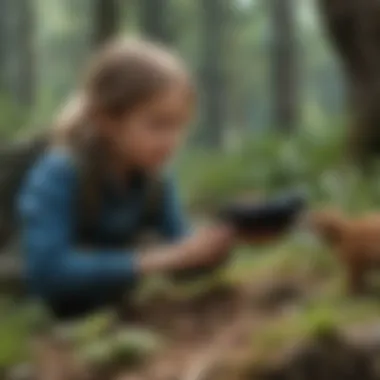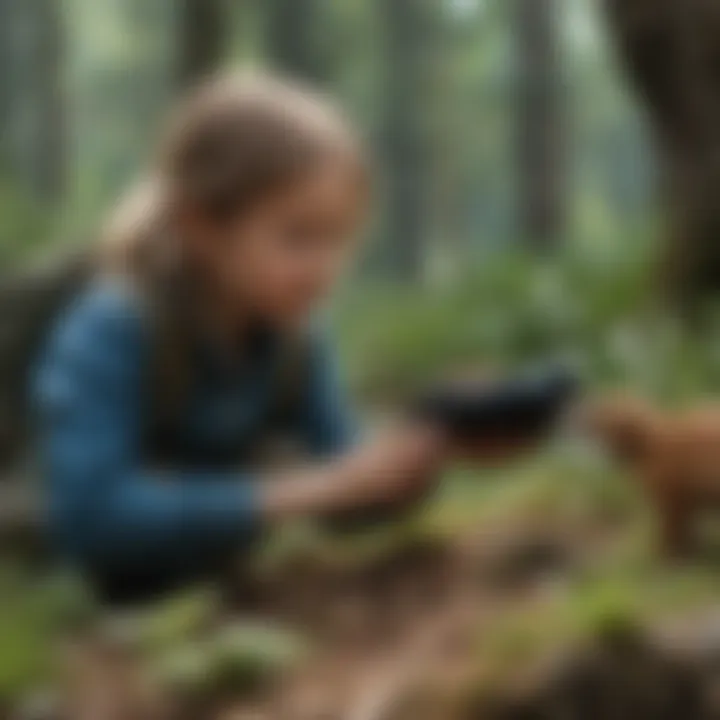Discover Your Animal Spirit: Fun Earth Day Quiz for Kids


Intro
This article invites young nature enthusiasts to embark on a journey of self-discovery by exploring their animal spirit. Understanding one's connection to the natural world can be both fun and enlightening. For children aged 5-12, this Earth Day quiz serves as a gateway to explore their love for animals, resonating with different traits and characteristics that species exhibit. Through simple questions and interactions, kids can unveil the animal that best aligns with their personalities.
Connecting with wildlife at an early age can spark curiosity about the environment and foster a sense of responsibility for its care. When young readers learn about different animal behaviors and habitats, they cultivate an appreciation for biodiversity. Thus, our main goals are to entertain, educate, and inspire through this innovative content.
Nature Topic Overview
This section introduces the activity of discovering animal spirits and highlights that animals exhibit behaviors and attributes often found in humans. This relationship opens dialogues around uniqueness, character, and individuality of young learners. By recognizing these links, children can reflect not only on their preferences but also form deeper connections with ecosystems.
The exploration begins with species identification and continues towards environmental stewardship, painting a robust picture of interconnectedness in nature. Engagement through quizzes makes the learning process enjoyable while instilling valuable lessons on appreciation and care.
Fun Facts and Trivia
To immerse young readers fully, incorporating captivating facts about animals can enrich their learning experience:
- Did you know some birds can mimic sounds from their environment, like chainsaws or other animals?
- Sea otters hold hands while they sleep to prevent drifting apart!
- A group of flamingos is called a
Intro to Earth Day and Its Significance
Earth Day is a devoted response to growing environmental concerns. It originated in 1970 as a movement emphasizing the essential connection between humans and the planet. Today, it occupies a critical position pointing out the need to protect nature and reverse environmental damage. For children, understanding Earth Day can cultivate lasting awareness.
What is Earth Day?
Earth Day occurs every April 22, focusing on environmental protection. Its inception marked a pivotal moment for global environmental consciousness. It aims to inspire individuals to recognize their impact on the planet and to desire change. Through educational initiatives, families and communities reflect on environmental practices. Activities organized for kids include nature walks, recycling drives, and educational workshops. Participation in these activities helps engage young minds with nature directly and advocates for hands-on solutions. When children learn about Earth Day, they develop a sense of identity as responsible stewards of the environment.
The Purpose of Earth Day
The core purpose of Earth Day lies in environmental education. Its goal is to highlight pressing issues, like climate change, pollution, and habitat loss. Moreover, Earth Day appeals to collective responsibility. Children embrace this idea by understanding the importance of preserving ecosystems, enhancing their environmental rapport. Other key aims are to cultivate sustainability attitudes and empower young people.
Earth Day not only elevates awareness. It spurs action and encourages individuals, especially children, to actively participate in preserving our natural world.
To summarise, fostering understanding of Earth Day for our young audience serves as a foundation for future environmental advocacy. Introducing them to this topic ensures they grow into informed, responsible adults, committed to defending the Earth's treasures.
Connecting with Nature Through Animal Spirit
Connecting with nature through the lens of animal spirits allows young learners not just to explore their affinities with the natural world but to develop a sense of identity and personal connection to the environment. This concept plays a vital role in fostering empathy toward wildlife, promoting a love for our planet, and instilling a curiosity about biodiversity.
Understanding Animal Spirits
Animal spirits, in this context, refer to the animals that resonate with a person's characteristics, preferences, and emotions. For children aged 5-12, recognizing these connections can be an enlightening experience. It encourages them to think deeply about the qualities they admire in animals and how these traits reflect within them. Sometimes, this can also foster meaningful relation between children and specific animals they might encounter in their local ecosystems.
This kind of understanding can impact young minds profoundly. When children identify with animal spirits, they often seek to learn more about those animals' habitats, behaviors, and roles in nature. The curiosity sparked here is essential. It helps foster environmental awareness and an appreciation for every life form. This integral process builds a strong foundation for future environmental practices.
Why Identify with an Animal?
Identifying personally with an animal goes beyond just making a favorite choice. It enables a deeper relatable connection to themes of strength, freedom, loyalty, or wisdom. Children learn to contemplate attributes that inspire them and explore how these characteristics manifest in their own lives.
Consider the following benefits of identifying with an animal:
- Enhanced Self-Understanding: Children can mirror the personality traits they see in animals, leading to greater self-awareness and personal growth.
- Empathy Development: As children align themselves with animals, they automatically learn empathy. This awareness can lead to a greater concern for animal welfare and nature conservation.
- Increased Environmental Responsibility: Those who feel connected to a certain animal may develop a desire to protect their habitats, encouraging stewardship of the earth.
- Cultural Awareness: Many cultures link animal spirits to specific traits or wisdom. Understanding these connections provides opportunities to delve deep into the ethics of various cultures and their respects towards nature.
Engaging kids to find their animal spirit becomes more than just a modern trend—it establishes a channel for nurturing their understanding of wildlife, respect for nature, and overall environmental consciousness.
The alignment between a child and an animal spirit provides unique opportunities for engagement, learning, and personal embrace of nature, creating a lasting impact as they grow.
The Earth Day Quiz Framework
The Earth Day quiz framework holds substantial significance, serving as the backbone of this entire initiative. Its main goal is to capture children's interest and curiosity about wildlife while rolling natue education into fun. This framework ensures that young learners engage meaningfully, making discoveries about their personalities and the environment.
Crafting a quiz specifically designed for children aged 5-12 enhances its effectiveness. The questions must be accessible, stimulating, and relatable. This demographic thrives on engaging material that encourages interactions and self-exploration. The quiz provides that appealing platform.
Quiz Objectives
The objectives of the quiz strike at the heart of both educational and enjoyment factor. Here are key aim that should alwasy be Included:


- Animal Recognition: Helps children learn various species and their roles in the ecosystem.
- Effective Self-Discovery: Encourages kids to identify their animal spirit, helping them learn more about personality traits connected to different species.
- Foster Empathy: Develops an understanding and appreciation for animals and the necessity for environmental stewardship.
Every question turned penny in the quiz must serve one of these objectives, guiding participants toward a deeper relationship with nature.
Target Audience and Engagement
To truly succeed, understanding the target audience is critical. In this case, it focuses on children aged 5-12, which means comprehension levels vary. Moreover, instructors, parents, and caregivers form part of the audience degign. Hence the content should ensure each segment is engaging while remaining simplified for ease of understanding.
"Ensuring kid-friendly content invites young learners into the world of nature."
Parents and teachers can play roles in guiding those quiz reactions. Sharing the quiz can lead to group discussions entirely following it, deepening understanding while maximizing engagement. Effective quizzes stimulate conversations about wildlife, helping children not just through facts but also through curiosity and shared laughter.
Crafting Effective Quiz Questions
Crafting effective quiz questions is essential for ensuring that the Earth Day quiz resonates well with young participants. For children aged 5-12, questions need to be simple yet engaging, directly aligning with their interests and developmental stage. Effective questions not only capture attention but also enhance the overall learning experience. When done appropriately, they also promote a sense of personal connection with nature.
Types of Questions for Young Learners
Personality Traits
Questions related to personality traits offer a unique approach to understanding animal spirits. This aspect contributes significantly by allowing children to reflect on their character. Most children relate strongly to given traits, such as friendliness or playfulness. The key characteristic here is self-reflection, which many kids find beneficial. For example, a child answering questions about being brave might discover an affinity for a lion. The unique feature of personality trait questions lies in their ability to ground the quiz in familiar concepts, making it relatable. However, one challenge is ensuring that the personality descriptions are age-appropriate and easily understood.
Favorite Environments
Favorite environments can highlight a child’s relationship with nature, enriching the quiz experience. This amkes for engaging content, enabling participants to visualize themselves in different settings. For instance, a question about chanting to choose between a desert or a forest taps into decisions they often make in play. Such choice invites diverse respondents and builds characteristics of their chosen animals. The distinct feature here is context; children can recall the various environments they may have visited or imagined. However, phrasing these questions requires careful consideration to ensure clarity for young, attentive minds.
Preferred Activities
Inquiring about preferred activities adds another layer to the quiz. These questions encourage children to think about how they enjoy spending their time outside. By having kids select between favorite actions, like running, swimming, or climbing, they may be directed towards specific animal spirits. The main trait of these activity-based questions is an active engagement with the natural world. Kids may draw correlations to animals known for those activities, such as dolphins for swimming or squirrels for climbing. Nevertheless, simplicity in activity description is crucial, as an over-complicated approach could reduce the appeal.
Ensuring Age-Appropriate Content
Making sure that quiz content is age-appropriate is vital. Content should fit the comprehension levels of 5 to 12 year olds. Attention should be made to the vocabulary used in questions. It's important to adjust language based on age groups while keeping it intriguing. This approach aids engagement and learning. Directly connecting to their experiences fosters an empathetic understanding of nature and can spark further interest in wildlife conservation.
It is crucial to evaluate quiz questions systematically, ensuring they are suitable for kids. Proper review can identify texts that might confuse, ultimately enhancing each child’s nature interaction.
Examples of Animals for the Quiz
Exploring the different types of animals in nature adds depth to the Earth Day quiz. Each category comes with its own unique traits that can resonate with a child's personality. Understanding these animal types helps children form connections with nature on a personal level.
Popular Animal Categories
Mammals
Mammals are warm-blooded creatures that typically possess hair or fur. Their ability to nurture their young through milk is a key characteristic. This makes them relatable for children as it mirrors their experiences with family. They occur in numerous habitats around the globe and can represent concepts like strength and adaptability.
Mammals tend to be a popular choice for quizzes due to their variety. From playful dolphins to mighty elephants, each mammal has unique behaviors. This diversity makes it engaging for children. Most children can instinctively identify with mammals because they share emotions and traits common in human behavior. However, children may find large mammals intimidating, which can lead to a fear of the unknown.
Birds
Birds are fascinating creatures that can fly, distinguishing them from many other animal types. They come in an array of colors and sizes, which broadens interest in avian species. Birds often symbolize freedom and exploration, making them an ideal choice for the quiz aimed at children.
One key characteristic of birds is their singing. This can resonate especially well with younger audiences who might be drawn to melodies and sounds. Additionally, observing birds can inspire curiosity about their habitats and lifestyles. One drawback is that exhibits of birds may not be as accessible for children in regions where avian life is scarce.
Reptiles
Reptiles are cold-blooded creatures covered with scales. They are often seen as more mysterious than other animals. This adds a layer of excitement in the context of the quiz. A key characteristic here is their ability to thrive in harsh conditions, making them resilient survivors. This message of adaptability can be a powerful lesson for young nature enthusiasts.
However, reptiles can be misunderstood. Kids might think of them as less appealing due to a perception of danger. This may lead children to overlook them in favor of cuddly mammals and vibrant birds. Providing accurate information can combat these fears and enhance understanding.
Insects
Insects are among the most diverse animals on earth, comprising a huge part of our ecosystem. They play crucial roles in pollination and decomposition. Their widespread presence allows easy identification for children, introducing them to the value of smaller beings. Important traits include multiplication rates and adaptability to various environments.
While insects may intimidate some children with their size or quick movements, educating them can enhance curiosity. This differs from other animal categories where much of the focus is on larger beings. Recognizing the importance of insects can empower children to understand how even the smallest creatures play essential roles in nature.
Unique Animal Characteristics


Animals have unique traits that can be fascinating for kids to learn about. Understanding these distinct features furthers their connectivity to nature and promotes enthusiasm for wildlife. Each animal's specific attributes can spark an interest in various ecosystems, fostering environmental literacy among children.
"Understanding unique animal characteristics can inspire a lasting commitment to wildlife and its conservation, crucial for future generations."
The Role of Visuals in the Quiz
Visuals play a crucial role in enhancing the experience of any quiz, especially one aimed at young learners. In the context of our Earth Day quiz focused on discovering animal spirits, illustrations and interactive elements are particularly important. They serve to not only engage children's attention but also to effectively convey information in a manner that resonates with their understanding and interests.
Importance of Illustrations
Illustrations act as a bridge that connects the imagination of children with the content of the quiz. A well-placed image can make a significant difference in a child's comprehension and enjoyment. Here are several benefits of using illustrations:
- Visual Appeal: Children are naturally drawn to colorful and attractive images. Good visuals can help to hold their attention and make the quiz more inviting.
- Reinforcing Learning: An image of a specific animal can reinforce the concepts that questions are exploring. For example, asking about the habitat of a polar bear becomes more meaningful when children see picture depicting icy terrain.
- Encouraging Identification: When kids visually see different animals, they may more easily identify with them. This can lead to a stronger result when it comes to understanding their animal spirit.
A random observatelist of what texts children may actually want to read could include stories about bears, dolphins, or owls that showcase each animal's unique traits.
Incorporating Interactive Elements
Incorporating interactive elements into the quiz provides an additional layer of engagement. This approach can capturate the imagintion of young hearts and help in understanding environmental principles in playful manners. Here are some key considerations for interactive elements:
- Drag-and-Drop Features: Implementing features that allow children to drag and drop animals into their respective environments can encourage active learning. For example, dragging an owl to a tree visual can show where it typically resides, facilitating knowledge retention.
- Clickable Images: When kids click on animal images, additional fun facts or sounds can be provided. This adds life to the quiz, making it feel more like exploring the animal kingdom instead of just answering questions.
- Gamification: Adding a points system for correct answers or quick responses can motivate children. They can feel accomplished as they see their scores increase, linking engagement with immediate rewards.
In summary, visuals are not just decorations; they carry the power to convert boring facts into delightful learning.
Visuals combine the essence of education and enjoyment. When young nature enthusiasts interact with the quiz effectively, not only greats moments of fun but also meaningful connections to nature are formed.
Promoting Environmental Awareness through the Quiz
Promoting environmental awareness through the quiz explores core issues in recognizing our connection with nature. This section is vital as it facilitates a deeper understanding of wildlife and ecosystems. Simply put, the quiz acts as an engaging tool. It encourages discussions about wildlife conservation and sustainability, pertinent topics in today’s world.
Children, when aware of the intricate relationships that define their environments, become better stewards of the planet. Through knowledge, they can learn to appreciate the intricate web of life surrounding them. It is not just about animals. Treasuring all forms of life encourages young minds to recognize the importance of biodiversity.
Some specific benefits of promoting environmental awareness through the quiz includes:
- Fostering a sense of responsibility among young individuals toward environmental issues.
- Enhancing observation skills, leading to greater appreciation of local ecosystems.
- Creating a foundation for discussions about conservation and the environment in education settings.
Ultimately, the fun aspect of a quiz can foster an eagerness to learn more about nature. Young children then frequently become engaged and curious visitors in nature. This delight inspires further conversations about caring for our planet. Kids begin to see themselves not in isolation, but as part of a broader community — connected to the earth and all living entities.
Understanding Biodiversity
Understanding biodiversity allows young nature enthusiasts to comprehend the variety of life forms around them. This foundational knowledge teaches children that every creature has a role to play. For example, bees are essential in pollinating plants. Loss of these tiny but pivotal creatures endangers the health of entire ecosystems.
Introducing children to different species shows them that the world is full of unique characteristics and behaviors. Knowledge—a spontaneous learning curve—about mammals, birds, insects, and reptiles builds not only awareness but also enthusiasts who may dedicate their lives to study these animals. Biodiversity itself respects and values this variety, acknowledging how everything works together while fostering connections.
In an engaging manner, the quiz highlights superhero-like qualities of different species. Knowledge empowers children. Their newfound appreciation encourages curiosity, creativity, and understanding in pathways that lead toward future environmental advocates.
Nature Conservation Education
Nature conservation education imparts essential lessons about protection of our earth. The quiz provides a platform to introduce this concept with relevant and engaging context. By showcasing how certain actions impact animal habitats, it encourages young individuals to evaluate their choices and behaviors.
For instance, discussing littering and its consequences raises awareness about local wildlife destruction caused by human behavior. The quiz might inspire thoughtful discussions:
- How does pollution affect a river’s fish?
- In what ways do habitats become threatened by urban development? This kind of information representation can lead to inquiries for kids to understand that they, too, play a pivotal part in the overall equation.
Furthermore, opportunities for sustained dialogue about conservation empowers participation in local conservation actions, such as community clean-ups. By incorporating principles of conservation into their learning, children can translate knowledge into actions that matter.
Incorporating educational resources about conservation strategies extends readiness for collaborative work. It encourages partnerships with local organizations that focus on wildlife conservation. Witnessing real-life efforts even reinforces their inquiries about how they can help and support ecological initiatives.
Education, activity, and initiative activate important dialogues that can shift mindsets about protection of spaces kept sacred for wildlife.
In sum, this section emphasizes promoting environmental awareness through the quiz, focusing on understanding biodiversity and nature conservation education. By encouraging strong connections through learning, children develop sensitivity to the natural world. They become the next generation to tackle nature’s greatest challenges.
Implementing the Quiz in Educational Settings
Working this quiz into educational structures has great value. Elementary schools and community centers can use it to introduce children to environmental ideas. The activity promotes curiosity about nature, serving as a fair tool to teach about ecosystems.
Another benfit includes steering kids toward critical thinking. The quiz engenders mindfulness about animal traits, behaviors, and habitats. Each question leads children to reflect on their choices, enabling them to connect practically.


The implementation process entails careful attention to adaptability. It must cater to various learning styles. Some children might better grasp facts via visual cues, while others benefit from discussing their answers in class.
Combining different lesson strategies enhances engagement and furthers understanding.
Integrating the Quiz into Lesson Plans
To tightly weave the quiz into lesson plans, teachers can opt for a structured approach. Anchoring the quiz with learning objectives is essential. For instance, aligning questions with local biodiversity themes engages students deeply and enhances retention. This targeted connection can guide further research activities or discussions about conservation practices.
Once incorporated, framing the activities around the quiz can further elevate the standard curriculum. Activities could feature:
- Wildlife observations around school grounds.
- Art projects illustrating discovered animal spirits.
- Class discussions on different animal roles in the ecosystem.
Starting with simple introductions to animal spirits sets a friendly atmosphere. Following that with quiz results allows for casual exploration—a chance for diverse animal discussion in the class.
Teachers may also engage students actively in quiz creation. Students enjoy askings questsions or contributing content for new quizzes, advancing concepts personally relevant to them.
Encouraging Group Participation
Group participation is highly advantageous within this quiz framework. Emphasizing teamwork creates a strong environment that enhances learning. When children discuss their results together, an exchange unfolds. Peers share interests and connect over favorite animals, creating comradship in discovery.
Facilitating such dialogue broadens perspectives. It enables an understanding of what makes a spirit animal special among cultures.
Teachers can encourage groups to come up with themes or presentations around their resulting animal spirits. Instead of just individual results, putting group-focused quizzes can spark fascinating discussions. Some actions to consider include:
- Organizing teamwork sessions or workshops based on quiz results.
- Hosting an activity day spotlight all student animal spirit discoveries.
- Dedicating time at the end for each child to explain their animal choice.
Leaning into possibilities for collaborative projects magnifies the idea, reinforcing positive connections in nature education.
Feedback and Improvement
In the context of an Earth Day quiz designed for young nature enthusiasts, feedback and improvement are pivotal. These elements ensure that the quiz not only meets educational goals but also continues to engage children effectively. Understanding how children respond and adapt to different questions can significantly influence future iterations of the quiz. This process of collecting feedback fosters an enriching learning environment.
Collecting Responses
Collecting responses after the quiz is vital for various reasons. Firstly, responses provide insight into children’s understandings of animal spirits and characteristics. Every answer offers clues about their preferences and values related to animals.
Secondly, quantifying the responses helps educators and parents assess which aspects of the quiz were most effective. Did they connect well with the kids? Which animals sparked excitement? By analyzing results, refinements can be made for clarity and interest.
Obtaining feedback can take various forms:
- Surveys: Simple questions can elicit feedback on enjoyment and engagement.
- Verbal Feedback: Direct discussions after the quiz can lead to more nuanced insights.
- Observation: Noticing behavioral responses during the quiz highlights aspects that resonate.
Effective data collection leads to valuable insights about the learning experience. Therefore, maintaining open channels for response is essential for a meaningful and educational quiz experience.
Adapting Questions for Future Quizzes
Adapting questions based on the collected feedback is an ongoing process. By revising quiz content, educators ensure the quiz evolves to be more relevant over time.
This might include rephrasing questions to eliminate confusion. It may also involve adding new animals that the kids seem interested in. Close attention to patterns in answers helps identify either gaps in knowledge or trends that excite young learners.
The revisions might be nuanced, including:
- Enriching content: Adding interesting facts about particular animals that involved varied responses.
- Seasonal updates: Adapting questions based on changing wildlife patterns in each new season.
- Emphasizing engagement: Shortening lengthy questions that children might find overwhelming.
By consistently refining questions, the quiz helps boost comprehension and maintain interest over multiple sessions. Feedback and improvement processes shift the quiz from a static tool to a dynamic learning platform for exploring the natural world.
The End: The Impact of the Animal Spirit Quiz
The concept of the animal spirit quiz serves more than just entertainment. It opens channels of communication between young minds and the environment around them. Acknowledging which animal resonates with a child's character can lay the groundwork for a variety of discussions about nature, wildlife, and the intricacies of ecosystems. Through engagement with the quiz, children learn to see themselves as part of a larger ecological community. This connection can motivate them to cultivate respect and appreciation for all forms of life.
In this rapidly changing world, fostering an interest in animals and their habitats can spark a sense of wonder. Identifying personal animal spirits helps children create bonds with specific species, deepening their fascination with nature. When children personalize their learning experience, they tend to retain information more effectively, thereby reinforcing educational objectives connected to environmental stewardship.
“Understanding your connections to animals empowers children to appreciate nature’s role in their lives.”
In sum, the impact of an animal spirit quiz extends beyond the quiz itself. It serves as a catalyst for discussions around biodiversity and conservation efforts—two critical areas for future generations. Cultivating awareness from a young age is essential in crafting environmentally responsible individuals.
Encouraging a Lifelong Connection with Nature
An effective animal spirit quiz can nurture a lifelong relationship with nature in children. When young people identify with an animal spirit, they often develop a desire to learn more about that species. This can lead to further exploration of habitats, behaviors, and critical dangers these animals face. Such intrigue often translates into real-life action, encouraging involvement in conservation activities and mentoring programs.
These experiences help sharpen observational skills and spark curiosity, pivotal traits for anyone exploring the natural world. Additionally, students gain awareness about ecosystems—the intricate systems consisting of plants, animals, and their interactions.
By identifying a special animal, kids might even carry aspects of their spirit animal into their lives. Whether it is a love for tigers, a curiosity about sea turtles, or any other wildlife, this alignment can teach lessons of resilience, patience, and harmony with nature.
Fostering Environmental Responsibility
Encouraging kids to embrace their animal spirit can foster a sense of responsibility towards nature. By making a personal connection with animals, children begin to understand how their actions affect ecosystems. For instance, a child aligned with a bumblebee may develop a keen interest in pollination and its effect on agriculture. This understanding is critical as they grow more socially conscious, eventually impacting attitudes toward climate change and environmental protection.
Through this type of reflection, youngsters become champions for change, committed to actions that promote sustainability. Campaigns, school projects or art exhibits focused on celebrating their selected animal can morph into platforms advocating for local or global wildlife conservation efforts. Preparing children to actively participate in the preservation of their chosen animal adds layers to their academic journey and instills principles of civic engagement.
Thus, the outcomes of participating in an animal spirit quiz extend well into adulthood, producing stewards of the planet who are aware of their responsibilities in safeguarding its future.







